AFV club 1/48 scale Sturmtiger
|
KIT #: |
48006 |
|
PRICE: |
$40.00 from the LHS
|
|
DECALS: |
No options |
|
REVIEWER: |
Tim Gillis |
|
NOTES: |
|

Sturmtiger is the common name of a World War II German assault gun built
on the Panzer VI Tiger I chassis and armed with a large naval rocket
launcher, the 38 cm Raketen-Werfer RW61 L/5.4. Its primary task was to
provide heavy fire support for infantry units fighting in urban areas. The
few vehicles produced fought in the Warsaw Uprising, the Battle of the Bulge
and the Battle of the Reichswald. The vehicle is also known under the names
Tiger-Mörser, Sturmmörser Tiger and Sturmpanzer VI.
Development
The idea for a heavy infantry support vehicle capable of demolishing heavily
defended buildings or fortified areas with a single shot came out of the
experiences of the heavy urban fighting in the Battle of Stalingrad in 1942.
At the time, the Wehrmacht had only the Sturm-Infanteriegeschütz 33B
available for destroying buildings, a Sturmgeschütz III variant armed with a
15 cm sIG 33 heavy infantry gun. Twelve of them were lost in the fighting at
Stalingrad.
Its successor, the Sturmpanzer IV was in production from early 1943, but the
Wehrmacht still saw a need for a similar, but heavier armoured and armed
vehicle. Therefore a decision was made to create a new vehicle based on the
Tiger tank and arm it with a 210 mm howitzer.
However, this weapon turned out not to be available at the time and was
therefore replaced by a 380 mm rocket launcher, which was adapted from a
Kriegsmarine depth charge launcher.
In September 1943 plans were made for Krupp to fabricate new Tiger I armored
hulls for the Sturmtiger. The Tiger I hulls were to be sent to Henschel for
chassis assembly and then to Alkett where the superstructures would be
mounted. The first prototype was ready and presented to Adolf Hitler in
October 1943. Delivery of the first hulls would occur in December 1943, with
the first three Sturmtigers completed by Alkett by 20 February 1944.
Due to delays, Hitler did not request production of the weapon until 19
April 1944; 12 superstructures and weapons for the Sturmtiger would be
prepared and mounted on rebuilt Tiger I chassis. The first three production
series Sturmtigers were completed by Alkett in August 1944. Plans to
complete an additional seven 38 cm Sturmtigers from 15 to 21 September 1944
were presented to Hitler in a conference on 18/20 August 1944. Ten
Sturmtigers were produced in September, along with an additional five in
December 1944.
Hitler had laid great importance on the special employment of the Sturmtiger
and believed it would be necessary to produce at least 300 rounds of
ammunition per month.
The main armament was the 380 mm Raketen-Werfer 61 L/5.4, a breech-loading
rocket launcher, which fired short-range, rocket-propelled projectiles.
These projectiles were roughly 1.5 metres (59 in) in length and could either
contain a high explosive charge of 125 kilograms (280 lb) or a shaped charge
for use against fortifications, which could penetrate up to 2.5 metres (98
in) of reinforced concrete. The stated range of the former was 5,650 metres
(6,180 yd). The weight of the complete rounds was 345 to 351 kilograms
(760–770 lb). A normal charge first accelerated the projectile to 45 metres
per second (150 ft/s), the 40 kilograms (88 lb) rocket charge then boosted
this to about 250 metres per second (820 ft/s).
The design of the rocket launcher caused some problems, as the hot rocket
exhaust could not be vented into the fighting compartment but neither could
the barrel withstand the pressure if the gasses were not vented. Therefore a
ring of ventilation shafts were put around the barrel which channeled the
exhaust and gave the weapon somewhat of a pepperbox appearance.
Because of the bulkiness of the ammunition, only 14 rounds could be carried,
of which one was already loaded, with another in the loading tray. The rest
were carried in two storage racks. To help with the loading of ammunition
into the vehicle, a loading crane was fitted at the rear of the
superstructure, next to the loading hatch. Even then, the entire five man
crew had to help with the loading.
It was intended that each Sturmtiger would be accompanied by an ammunition
carrier built on the same tiger 1 chassis but only one carrier was
completed[1].
At the loading hatch's rear was located the 90 millimetres (3.5 in) NbK 39
Nahverteidigungswaffe ("Close defence weapon"), which was used for close
range defence against both armoured vehicles and infantry. This could be
used in a 360 degree circle around the vehicle and was basically a short
range grenade launcher.
For defence against infantry attacks, there was a mount in the front for a
7.92 mm MG34 machine gun.
The original role of the Sturmtiger was intended to be as a heavy infantry
support vehicle, to help with attacks on heavily fortified or built-up
areas. By the time the first Sturmtigers were available however, the
situation for Germany had changed for the worse, with the Wehrmacht being
almost exclusively on the defensive rather than the offensive.
Three new Panzer companies were raised to operate the Sturmtiger: Panzer
Sturmmörser Kompanien (PzStuMrKp) (Armored Assault Howitzer Company) 1000,
1001 and 1002. These originally were supposed to be equipped with fourteen
vehicles, but this figure was later reduced to four each, divided into two
platoons.
PzStuMrKp 1000 was raised on 13 August 1944 and fought during the Warsaw
Uprising with two vehicles, as did the prototype in a separate action, which
may have been the only time the Sturmtiger was used in its intended role.
PzStuMrKp 1001 and 1002 followed in September and October. Both PzStuMrKp
1000 and 1001 served during the Ardennes Offensive, with a total of seven
Sturmtigers.
After this offensive, the Sturmtigers were used in the defence of Germany
proper, mainly if not exclusively at the Western front. They proved to be
excellent defensive weapons, hard to destroy except by air attack or heavy
artillery bombardment. Few Sturmtigers were therefore destroyed by enemy
action, with most being destroyed or abandoned by their crews after either a
mechanical breakdown or because of fuel shortage.
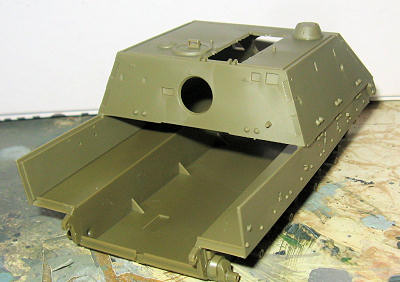 (Editor's
Note: Tim did not send in an image of all the parts, just some sections)This is AFV clubs 1/48 scale 38cm RW61 auf Sturmmorser. Tiger, more commonly
known as the Sturmtiger. At first glance, one will see a sticker on the
upper right corner which reads "Special parts, first edition only", which
indicates there will be something missing from future boxings of this kit.
On the left side of the lid, one can also read about the included details;
Highly detailed engine compartment and structure, Finely detailed crane for
munitions, Photo etch detailing parts included.
(Editor's
Note: Tim did not send in an image of all the parts, just some sections)This is AFV clubs 1/48 scale 38cm RW61 auf Sturmmorser. Tiger, more commonly
known as the Sturmtiger. At first glance, one will see a sticker on the
upper right corner which reads "Special parts, first edition only", which
indicates there will be something missing from future boxings of this kit.
On the left side of the lid, one can also read about the included details;
Highly detailed engine compartment and structure, Finely detailed crane for
munitions, Photo etch detailing parts included.
More on this later.....
Upon opening the sturdy card board box one is confronted with 5 sealed
plastic bags, a set if rubber tracks, then instructions and at the bottom a
picture the size of the box of the box art, labeled "Box art collection
#8 Sturmtiger AF48006" the kit number. As there are apparently no
markings on the depicted vehicles, there are no decals included.
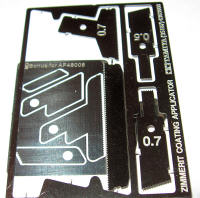 While the road wheels are represented on 2 sprues sealed in a single bag,
the rest of the sprues, as well as the upper and lower hull are individually
wrapped. Only the upper hull, and one sprue, are unique to this kit. This
sprue also contains the "Special bonus", which consists of a photo etch fret
of 4 spatulas with teeth to assist in creating zimmerit on models.
While the road wheels are represented on 2 sprues sealed in a single bag,
the rest of the sprues, as well as the upper and lower hull are individually
wrapped. Only the upper hull, and one sprue, are unique to this kit. This
sprue also contains the "Special bonus", which consists of a photo etch fret
of 4 spatulas with teeth to assist in creating zimmerit on models.
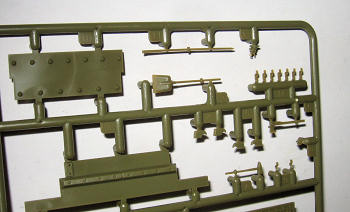 The other 4 bags, which include the lower hull are from their AF48001 sd.Kfz.
181(tiger) late model kit. The bag which contains the 2 sprues of road
wheels also contains screws, for attaching the road wheels, and the photo
etch parts, which are the 4 deck screens and what looks like a gun sight,
all nicely rendered. The other sprues contain parts that are intended solely
for the Tiger I, so there will be a few bits and pieces for the spares box.
The other 4 bags, which include the lower hull are from their AF48001 sd.Kfz.
181(tiger) late model kit. The bag which contains the 2 sprues of road
wheels also contains screws, for attaching the road wheels, and the photo
etch parts, which are the 4 deck screens and what looks like a gun sight,
all nicely rendered. The other sprues contain parts that are intended solely
for the Tiger I, so there will be a few bits and pieces for the spares box.
Impressions:
On the negative side:
The box states that there is a highly detailed engine compartment, this kit
contains no interior parts whatsoever. It strikes me that there was
something lost in the translation, this could be considered misleading, how
ever, any kit I've seen with an interior advertises it as a complete
interior, and I've not seen any kit with a detailed engine compartment, and
nothing else, usually it's the other way around if you get anything at all.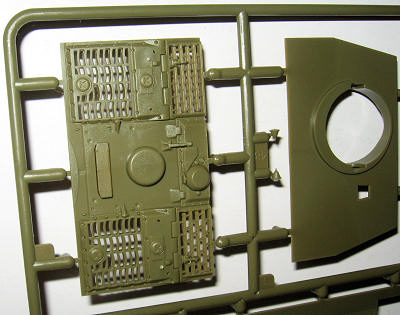
The "Special parts" are a useful tool, how ever, on comparing them to the
Tamiya set, which is for 1/35 scale, the teeth have the same spacing on both
sets, and comparing them to the zimmerit as it's rendered on the kit, the
teeth are to large. It is a nice bonus if you are not to fussy.
This leads to the other issue, The upper hull skirts are supposed to be
zimmerited, according to the instructions, and while the Tiger one parts
used in this kit are, the upper hull is not. This may be due to a future
release, How ever, I would have preferred the separate parts for the
zimmerited version, then try to mimic the zimmerit that is already there.
Looking at the way the upper hull is molded, while it might have made the
build a bit more finicky, this would still not be as much an issue as
applying the missing zimmerit.
The Other issue is the upper hull, which is slide molded, there are some
nice welding detail and the edges do have the look of being cut by a torch,
that said, right in the middle of that detail is what looks like round rod
sticking through the welds and marri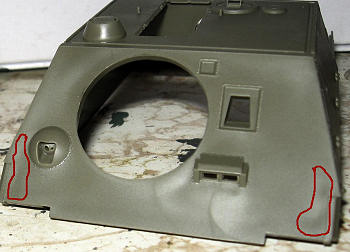 ng the detail on either side. not the
end of the world, but will be a bit difficult to remove with out damaging
the other wise nice detailing.
ng the detail on either side. not the
end of the world, but will be a bit difficult to remove with out damaging
the other wise nice detailing.
Also, on the front plate, where the gun attaches, there are some noticeable
sink marks, which follow the shape of the upper structure, and while they
are not that deep, are going to be difficult to fill giving the surrounding
detail. This issue does not affect the rest of the molding.
On the positive side:
The kit, aside from the previously mentioned issues, is well molded with no
flash, no ejector pin marks, and seem lines which are very slight and easily
removed. The weld seems and cuts are well rendered, and the cast parts well
represented, not being overdone for this scale. The Zimmerit texture, where
it is represented is also well done.
All the tools are separate pieces and look to be to scale as are the grab
handles. There is an optional rear hatch, one with a horizontal, and one
with a vertical grab handle. As well, although not called for in the
instruction, there is a set of side fenders provided as well in the tiger I
parts, so there are some options available.
On test fitting the upper and lower hull haves, fit was quit good, and while
this does not appear to be a complex kit, it does not appear to be over
simplified either. Although there is no interior provided, al the hatches
open, and have interior details, hopefully AFV Club, or some one, will offer
a full interior in the future. AFV Club does do a set of tracks with
individual links in this scale for the Tiger I, which will fit this kit if
one so desires, but as it is, the rubber tracks do not look that bad, and
are supposed to go together with regular cement. No doubt some photo etch
will be forth coming, hopefully with some zimmerit for the side panels.
Despite the few annoyances, which I think are typical of most kits, I'm quit
happy overall with my purchase. The instructions are easy to follow and
offer two schemes one of PzStuMrKp 1001, western front, 1945, in a three
tone camo pattern, and an unknown in an ambush scheme. With that, It looks
to be a reasonably well rendered, and easy to construct kit of a subject
that I am looking forward to building.
http://en.wikipedia.org
Tim Gillis
June 2009If you would like your product reviewed fairly and quickly, please
contact
me or see other details in the
Note to
Contributors.
Back to the Main Page
Back to the Previews Index Page


 (Editor's
Note: Tim did not send in an image of all the parts, just some sections)This is AFV clubs 1/48 scale 38cm RW61 auf Sturmmorser. Tiger, more commonly
known as the Sturmtiger. At first glance, one will see a sticker on the
upper right corner which reads "Special parts, first edition only", which
indicates there will be something missing from future boxings of this kit.
On the left side of the lid, one can also read about the included details;
Highly detailed engine compartment and structure, Finely detailed crane for
munitions, Photo etch detailing parts included.
(Editor's
Note: Tim did not send in an image of all the parts, just some sections)This is AFV clubs 1/48 scale 38cm RW61 auf Sturmmorser. Tiger, more commonly
known as the Sturmtiger. At first glance, one will see a sticker on the
upper right corner which reads "Special parts, first edition only", which
indicates there will be something missing from future boxings of this kit.
On the left side of the lid, one can also read about the included details;
Highly detailed engine compartment and structure, Finely detailed crane for
munitions, Photo etch detailing parts included. While the road wheels are represented on 2 sprues sealed in a single bag,
the rest of the sprues, as well as the upper and lower hull are individually
wrapped. Only the upper hull, and one sprue, are unique to this kit. This
sprue also contains the "Special bonus", which consists of a photo etch fret
of 4 spatulas with teeth to assist in creating zimmerit on models.
While the road wheels are represented on 2 sprues sealed in a single bag,
the rest of the sprues, as well as the upper and lower hull are individually
wrapped. Only the upper hull, and one sprue, are unique to this kit. This
sprue also contains the "Special bonus", which consists of a photo etch fret
of 4 spatulas with teeth to assist in creating zimmerit on models. The other 4 bags, which include the lower hull are from their AF48001 sd.Kfz.
181(tiger) late model kit. The bag which contains the 2 sprues of road
wheels also contains screws, for attaching the road wheels, and the photo
etch parts, which are the 4 deck screens and what looks like a gun sight,
all nicely rendered. The other sprues contain parts that are intended solely
for the Tiger I, so there will be a few bits and pieces for the spares box.
The other 4 bags, which include the lower hull are from their AF48001 sd.Kfz.
181(tiger) late model kit. The bag which contains the 2 sprues of road
wheels also contains screws, for attaching the road wheels, and the photo
etch parts, which are the 4 deck screens and what looks like a gun sight,
all nicely rendered. The other sprues contain parts that are intended solely
for the Tiger I, so there will be a few bits and pieces for the spares box.
 ng the detail on either side. not the
end of the world, but will be a bit difficult to remove with out damaging
the other wise nice detailing.
ng the detail on either side. not the
end of the world, but will be a bit difficult to remove with out damaging
the other wise nice detailing.